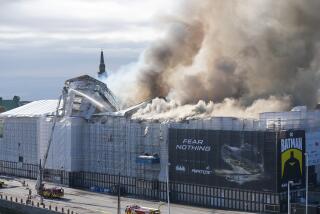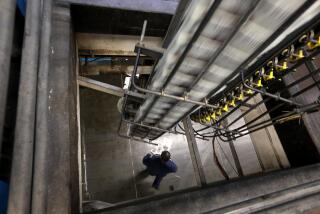Danish Weekly Entering Digital Age
Poul Andersen moved deliberately through the piles of ancient newspapers that seem to fill his cramped newsroom with a musty but nostalgic feel for the good old days, when editors and reporters slaved on manual typewriters and printers struggled with clanking Linotype machines.
Andersen, the publisher of the nationâs only Danish-language weekly newspaper, Bien, was searching for a back issue. Amazingly, he found it.
âI know where things are around here,â he said to a stunned visitor trying to take in the atmosphere of Bienâs cluttered Burbank newsroom. âIâve been in the newspaper business for more than 40 years. This is how I do it.â
Founded in 1882 by a Norwegian priest, Bien has been covering events in Denmark for readers in the United States for more than a century.
But change may be near at the paper, where ink-stained floors and machinery that looks more suited to a Smithsonian exhibit share space within a small, single-story building that betrays none of the rich history within. Judy Andersen, co-publisher of the paper as well as Poulâs wife, is trying to bring Bien into the Computer Age.
âJust donât mention it to Poul,â she whispered as her husband moved his manual typewriter from shelf to desk. âWe donât have a date yet, but itâs coming.â
She recently took a computer into the newsroom. Although it is used from time to time, it remains under a sheet and out of sight most of the time.
For now, Bien depends on its two Linotype machines. Each issue, printed almost entirely in Danish, is laid out by hand. Each line of print is individually cast by Linotype machines, which include a gurgling pot of molten lead and a maze of gears and belts. Andersen sits at the machine, working it like a loom, on deadline days.
âItâs pretty amazing heâs still using the Linotypes,â said David Sams, a manager of the California Newspaper Publishers Assn. âPoulâs the last of the traditionalists. Heâs holding on to a practice from a long time ago. Heâs the only one in the state, that I know of, that still does it that way.â
Although newspapers nationally are suffering a gradual decline in readers, Bien is growing. Its circulation topped 5,300 this year for the first time, the Andersens say proudly.
âItâs a wonderful newspaper,â said Jorgen Grunnet, minister counselor at Denmarkâs embassy in Washington, where two copies of Bien are delivered each week. âThey cover serious stuff and light stuff. You simply have to remember itâs not a big daily paper, itâs a special interest paper. But not so specialized. I know people in Denmark who have subscriptions.â
*
The paper was founded in San Francisco, but Andersen moved it to Burbank in 1951, upon buying it for âa small sum.â
Why Burbank?
âBecause we live here,â Andersen said, gesturing to Judy. âMore Danish-born people live in the Midwest, and some read our paper. But we live here so we publish here.â
Poul Andersen arrived in California from Denmark in 1949, landing a printing job at the Los Angeles Times. A couple of years later his future wife arrived from England. They met, fell in love, âand the rest is history,â Poul said.
Despite their differing nationalities, both knew they were destined to publish a newspaper. âWeâve got ink in our veins,â Judy said. In the early 1950s, Bien came onto the market as a possible investment, and even though it was and remains strictly Danish, both Andersens jumped at the opportunity.
âWhen I married this guy, I quickly got into the Danish thing,â Judy said.
Queen Margrethe of Denmark knighted Poul in 1982 for his newspapering efforts. He proudly shows off the iron cross denoting his knighthood to those who question the success of Bien. Judy smiles broadly when he brings out the award. But while the Andersens share a love for newspapers, soccer is a different story.
âPoulâs a fanatic about soccer,â Judy said. âPeople call the office all the time to get scores from games in Denmark or Europe. Iâd never been to a game before I met him. But, honestly, I could take it or leave it.â
On the wall behind Andersenâs desk are three identical clocks, each set to the local time of an âimportantâ city: Los Angeles, Washington and Ringkobing. The latter is Andersenâs hometown in Denmark, about 175 miles west of Copenhagen, the capital.
*
It seems the clocks are for Poul to better coordinate his soccer-viewing schedule than to keep the worldâs events in timely perspective.
âHeâs simply a soccer fanatic, heâs rabid,â Judy said. âLike with those machines.â
In the back room, where one Linotype machine was audibly switched on, Poul demonstrated his skills.
âTheyâre great,â he said, as he sat down beside a machine. âJust amazing theyâre still working.â
âAmazing indeed,â Judy said, before walking over to her desk, where the computer sits.
More to Read
Sign up for Essential California
The most important California stories and recommendations in your inbox every morning.
You may occasionally receive promotional content from the Los Angeles Times.










